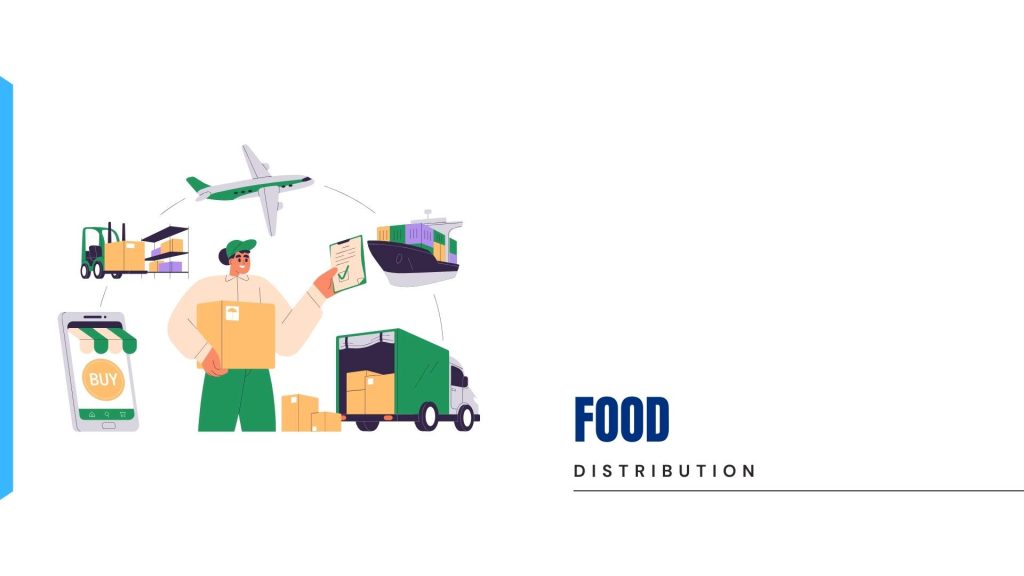The food distribution industry is the logistical cornerstone of our modern global food system, orchestrating the intricate journey of sustenance from farm to table. This dynamic sector ensures the availability of diverse food options, Spanning a complex network of suppliers, producers, wholesalers, retailers, and consumers.
It plays a pivotal role in maintaining food safety standards, optimizing supply chains, and meeting the ever-evolving demands of an interconnected world. From the massive scale of international trade to the local precision of neighborhood markets, the food distribution industry is a vital conduit, harmonizing the complex interplay between production, distribution, and consumption to nourish populations worldwide.
The Impact of ERP Systems on Food Distribution Efficiency
Supply Chain Visibility And Coordination
ERP systems offer real-time insights into inventory levels, enabling better coordination among suppliers, manufacturers, and distributors. This visibility reduces delays, minimizes stock outs, and enhances overall supply chain efficiency.
Efficient Order Management
Automation within ERP systems optimizes order processing, reducing errors and ensuring timely deliveries. This efficiency improves customer satisfaction and strengthens relationships with retailers and consumers.
Demand Forecasting And Planning
ERP systems facilitate accurate demand forecasting by utilizing recorded data and predictive analytics. It enables food distributors to plan production and inventory levels effectively, minimizing excess or insufficient stock.
Food Safety And Traceability
Traceability is crucial in the food industry. ERP systems track products from origin to shelf, enabling quick recalls if necessary, enhancing food safety standards, and ensuring compliance with regulations.
Cost Optimization
By streamlining processes, reducing waste, and enhancing resource allocation, ERP systems contribute to cost reduction, improving overall profitability in food distribution.
Challenges of Implementing ERP Systems in Food Distribution
Initial Costs And Resource Allocation
Implementing ERP systems requires significant investment in software, training, and infrastructure. Allocating resources while managing ongoing operations can be challenging.
Data Integration And Migration
Merging existing data from disparate systems into a new ERP setup without compromising accuracy or losing crucial information poses a significant challenge during implementation.
Scalability And Customization
Adapting ERP systems to evolving business needs and scaling them to accommodate growth can be complex. Balancing standardization with customization is crucial for optimal functionality.
Future Advancements and Trends in ERP Systems for Food Distribution
AI And Machine Learning Integration
AI and machine learning advancements will enhance predictive analytics, improving demand forecasting and supply chain optimization within ERP systems.
IoT And Real-Time Monitoring
Integration of IoT devices for real-time monitoring of inventory, temperature, and other variables will further enhance traceability and food safety measures.
Blockchain For Transparency
Blockchain technology could revolutionize transparency in the food distribution chain, ensuring immutable records for traceability and compliance.
Enhanced Mobile Capabilities
ERP systems will likely see improved mobile functionalities, enabling stakeholders to access critical information and perform tasks on the go, enhancing overall efficiency.
Food Distributors Without ERP Software: What Can Go Wrong?
Manual And Disparate Processes
Relying on manual processes or disparate systems leads to inefficiencies, errors, and a lack of centralized control, hampering operational agility.
Lack of Real-Time Visibility
With ERP systems, visibility into inventory levels, orders, and supply chain processes can lead to delays, stockouts, and better decision-making.
Limited Reporting and Analysis
Strategic decision-making becomes challenging without robust ERP-generated reports and analytics, impacting long-term profitability and growth.
Inefficient Order Processing
Manual order processing without ERP automation leads to errors, delays, and inconsistencies in fulfilling customer demands, affecting customer satisfaction.
Implementing ERP systems in food distribution is pivotal for streamlining operations, ensuring compliance, and staying competitive in an evolving market landscape. While challenges exist, the benefits far outweigh the initial hurdles, paving the way for enhanced efficiency, cost savings, and sustained growth.
How Can Acumatica Enhance?
Acumatica Cloud ERP is a transformative solution poised to revolutionize the food distribution landscape. Its robust features, including real-time visibility, seamless integration, and scalability, offer unparalleled advantages.
Acumatica empowers food distributors to optimize operations, ensure compliance, and elevate customer satisfaction by providing comprehensive supply chain management, precise inventory tracking, and dynamic demand forecasting.
The agility of cloud-based accessibility coupled with Acumatica’s advanced capabilities fosters efficiency, cost-effectiveness, and innovation, positioning food distributors at the forefront of an increasingly competitive market while ensuring sustained growth and success in the ever-evolving industry.

Sangeetha brings 20 years of experience in Information Technology which includes Solution architecting, building micro services, research, and evaluation of business applications, integrating apps.

